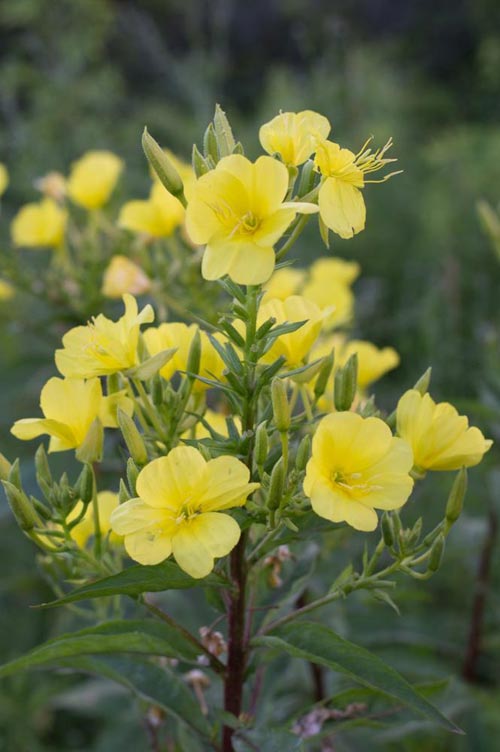Study finds variation within species is a critical aspect of biodiversity

Varieties of evening primrose (Oenothera biennis) show variation in leaf chemistry, leading to differences in the insect communities in different fields. Credit: Nash Turley Usage Restrictions: For use only with news coverage of this research.
Concerns about biodiversity tend to focus on the loss of species from ecosystems, but a new study suggests that the loss of variation within species can also have important ecological consequences.
Many species play important roles in nature and provide services important to people. For example, many fish species are harvested for food, and many insect species pollinate wild and cultivated plants. The loss of these species may mean the loss of ecosystem services, a major motivation for preventing species extinctions. The new study, published December 4 in Nature Ecology & Evolution, found that the ecological effects of within-species variation may be far reaching and often rival those of species themselves.
“It's not just the loss of whole species that we should be concerned about. We also need to pay more attention to the ecological consequences of variation within species,” said lead author Simone Des Roches, a postdoctoral researcher at UC Santa Cruz.
Variation within species affects how organisms interact with each other and their surrounding environment. For example, the size of a fish's mouth, known as its gape, determines the size of prey it can eat. And the variety of noxious chemicals a plant produces controls which insects chew its leaves. Much of the time, traits like fish gape and leaf chemistry are adaptive. They help organisms live in a changing world. However, much less is known about how variation within species affects broader ecosystems.
Variation within species can influence ecosystems through both direct and indirect ecological effects. Direct ecological effects can occur when trait differences affect the abundance or types of prey or resources an organism consumes, such as when the gape size of fish influences the kinds of plankton prey that survive in lakes or when leaf chemistry determines the grazing insects that inhabit a field. However, those prey or grazers often have diverse other interactions and roles in ecosystems that can be further altered. Ecological effects caused by such chains of interactions are known as “indirect effects.”
The study by Des Roches and her collaborators examined all available studies that compared the ecological effects of variation within species to the effects of species presence (removing the species or replacing it with another). They included 25 studies measuring a total of 144 different ecological responses from various types of plants, animals, and fungi. Their results show that variation within species, such as the effects of large- and small-gaped fish populations on zooplankton, are often similar to–and can sometimes be stronger than–species effects.
On average, species tend to have larger effects on ecosystems. Yet over a third of studies examined showed that swapping different variants of the same species had similar ecological effects as removing that species entirely or replacing it with a completely different species.
“Traditionally, ecologists have focused on the ecological importance of biodiversity among species. This paper broadly establishes within-species biodiversity as critical for ecology,” said coauthor Eric Palkovacs, associate professor of ecology and evolutionary biology at UC Santa Cruz.
Nearly half of all the studies documented at least one ecological response that was more strongly affected by variation within species than by its presence. In a surprising result, within-species variation was shown to have the largest impacts on organisms that the focal species wasn't directly consuming or evading. In other words, trait variation within species appears most important for indirect effects.
The study suggests that protecting trait variation within species is not only important for the future of evolution, but also potentially critical for the functioning of current and future ecosystems, according to Palkovacs. “This is a sobering thought given that human activity is causing within-species variation to be lost at a far greater rate than the extinction of entire species,” he said.
###
In addition to Des Roches and Palkovacs, the coauthors of the paper include David Post at Yale University; Nash Turley at the University of Central Florida; Joseph Bailey and Jennifer Schweitzer at the University of Tennessee; Andrew Hendry at McGill University; and Michael Kinnison at the University of Maine. This work was funded by the Quebec Centre for Biodiversity, the UC Institute for the Study of Ecological and Evolutionary Climate Impacts, the David and Lucile Packard Foundation, and the National Science Foundation.
Media Contact
All latest news from the category: Life Sciences and Chemistry
Articles and reports from the Life Sciences and chemistry area deal with applied and basic research into modern biology, chemistry and human medicine.
Valuable information can be found on a range of life sciences fields including bacteriology, biochemistry, bionics, bioinformatics, biophysics, biotechnology, genetics, geobotany, human biology, marine biology, microbiology, molecular biology, cellular biology, zoology, bioinorganic chemistry, microchemistry and environmental chemistry.
Newest articles

First-of-its-kind study uses remote sensing to monitor plastic debris in rivers and lakes
Remote sensing creates a cost-effective solution to monitoring plastic pollution. A first-of-its-kind study from researchers at the University of Minnesota Twin Cities shows how remote sensing can help monitor and…

Laser-based artificial neuron mimics nerve cell functions at lightning speed
With a processing speed a billion times faster than nature, chip-based laser neuron could help advance AI tasks such as pattern recognition and sequence prediction. Researchers have developed a laser-based…

Optimising the processing of plastic waste
Just one look in the yellow bin reveals a colourful jumble of different types of plastic. However, the purer and more uniform plastic waste is, the easier it is to…



